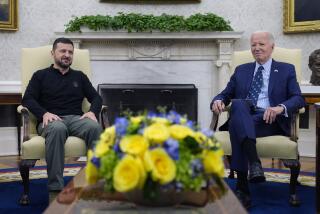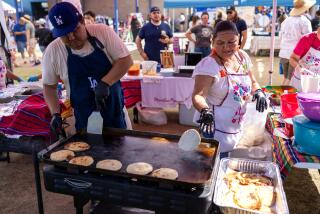U.S. Military Assistance to El Salvador Negates Benefits of Economic Aid
Panic struck the Salvadoran refugee community of Los Angeles last month when a rumor spread that the end of amnesty for illegal immigrants would also eliminate the long hoped-for possibility for political asylum. The rumor was false, but the error behind it is understandable. It is the flip side of an error that Americans make when we presume that every Spanish-speaker who crosses our southern border has come here for economic reasons.
I have just returned from a church-sponsored visit to a group of Salvadoran refugees who have returned home from Honduras at extreme personal risk. Like them, many Salvadoran refugees in Los Angeles would only too gladly go home. Ironically, it is the United States that prevents their return.
In November, 1987, the foreign policy caucus of Congress reported that U.S. aid to El Salvador had exceeded that country’s own national budget--a first in the histoby of U.S. foreign aid. Fiscal year 1988 aid of $608 million was 105% of El Salvador’s $582 million contribution to its own budget. Even excluding one-time earthquake relief assistance, El Salvador is approaching the record of dependence on U.S. aid held by South Vietnam at the height of the Vietnam War.
On what is the American money being spent? Claims that it is being spent on economic assistance ring a bit hollow when the Salvadoran unemployment rate is 30% and its annual inflation rate 40%. More important, whatever U.S. economic assistance may do to bring Salvadorans home, U.S. military assistance more than negates it by driving other Salvadorans into exile.
Many Americans may remember Operation Phoenix, the South Vietnamese program to identify Viet Cong, which some said was nothing more than an assassination program. Too few of us know that El Salvador had its own Operation Phoenix in 1986: a massive and brutal counterinsurgency campaign of the Salvadoran army, orchestrated by U.S. advisers and modeled after the Vietnam operation. The goal of the Salvadoran operation was twofold. First, to burn all vegetation, including subsistence crops. Second, to destroy everything else, including livestock and people who couldn’t run fast enough, thatmight be of use to those who oppose the Salvadoran armed forces.
In the Guazapa area about 10 miles north of San Salvador, to choose one example, the operation was judged a huge “success.” In the first three months, 200 civilians were killed. By the end of the year, 6,000 civilians had been driven into exile and their homes, crops and livestock destroyed.
Similar “successes” in dozens of other areas continue a process begun in 1980 that has left 1 million of El Salvador’s 5 million people internally displaced. Another 1 million fled to the United States and Canada--a refugee rate exceeded, if anywhere, only in Afghanistan.
Driving these Salvadorans into exile was not enough. It has been necessary to keep them in exile if the guerrillas are to be starved out. This the Salvadoran military has done by regular high-speed strafing runs employing American-made and American-supplied A-37 jet aircraft and by frequent forays through the target regions, killing, maiming and arresting.
Campesinos (peasants) live off the land. Guerrillas also live off the land, and inevitably also off the campesinos. By the logic of counterinsurgency, campesinos are all guerrilla collaborators. In the eyes of the Salvadoran army, to be living off the land in a place like Guazapa is in and of itself a crime.
In all, four sites in three rural provinces have been re-populated by about 4,500 Salvadorans who have decided to return from their various refuges to their bombed-out homes, come what may. The human cost is high. Guarjila, a village of 500 children, 300 women and 200 men, was sprayed with machine-gun and automatic-rifle fire on the day before our delegation visited it. And yet these Salvadorans, strong both in their patriotism and in their faith, are willing to pay the cost. Others like them, including those living in fear in Los Angeles, will start to return home as soon as the United States decides that 105% of El Salvador’s state budget is too much American money to spend on driving that little country’s people into exile.
More to Read
Sign up for Essential California
The most important California stories and recommendations in your inbox every morning.
You may occasionally receive promotional content from the Los Angeles Times.










